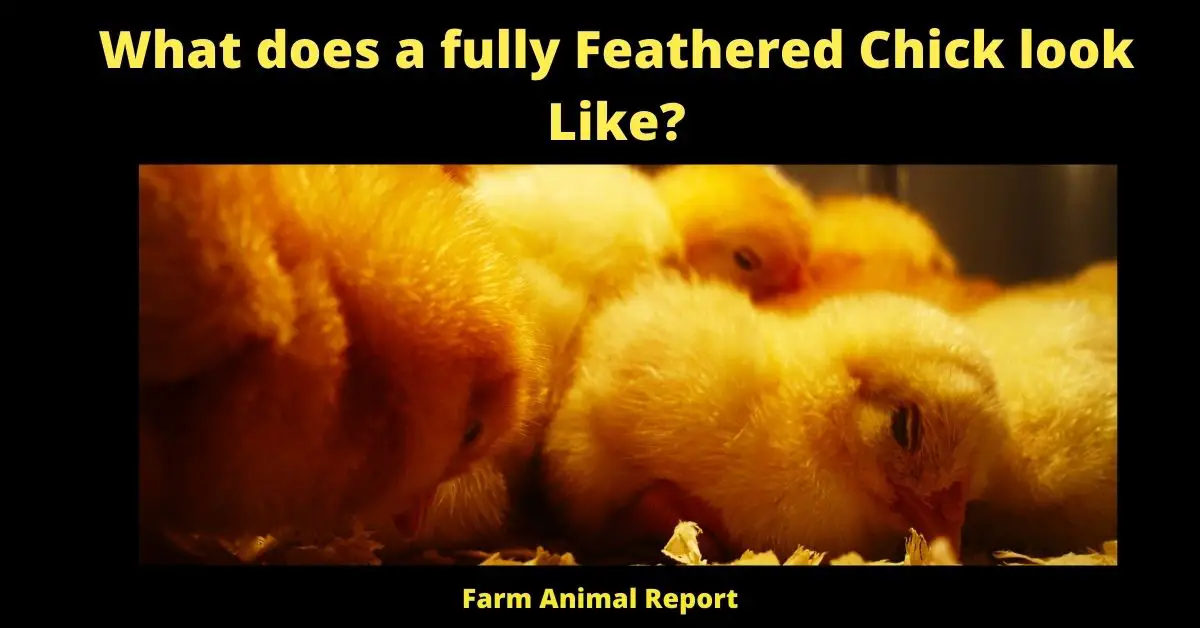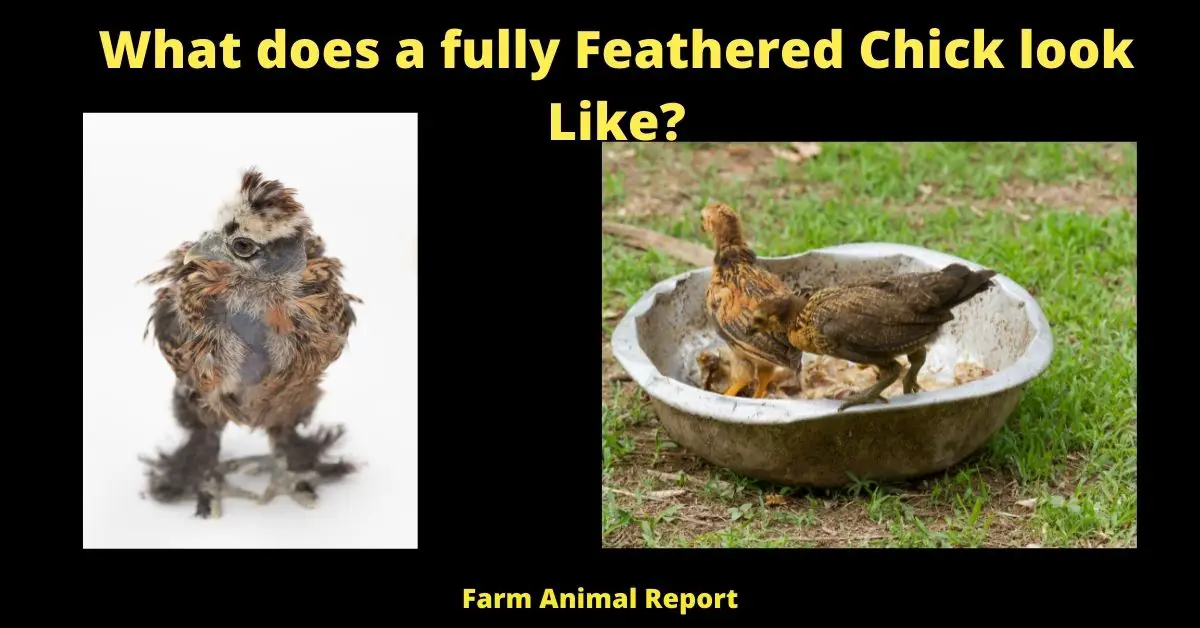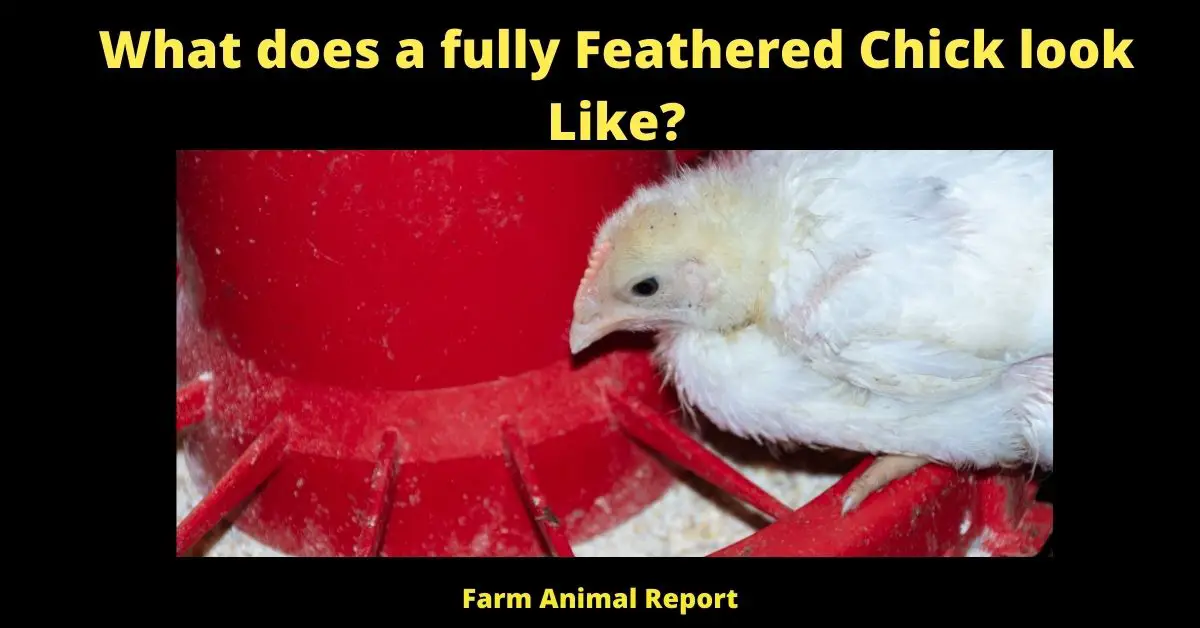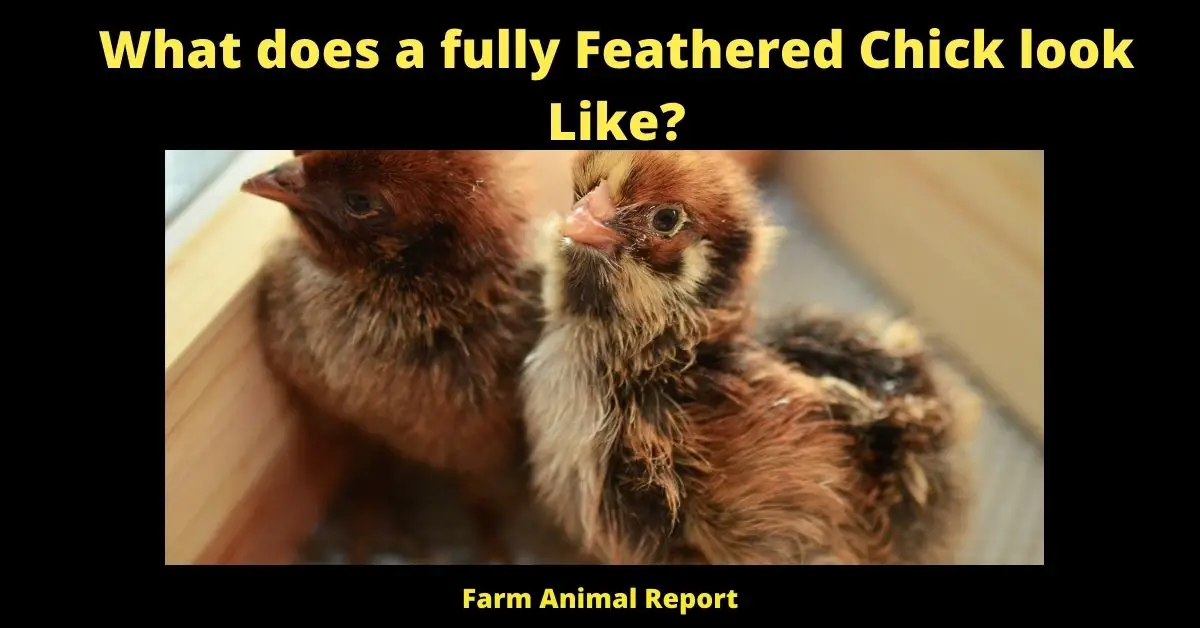Fully Feathered Chicks – During the first stage, known as “pinfeathers,” the chick begins to grow its first feathers. These feathers are short, stiff, and sharp, and they provide little insulation or protection. As the chick grows older, its pinfeathers will be replaced by softer down feathers.
The second stage of feathering occurs when the down feathers are replaced by “covert” feathers. These feathers are larger and more protective than down feathers, but they’re still relatively soft and flexible. The covert feathers help to keep the chick warm and dry, and they provide some protection from predators.
Finally, the third stage of feathering sees the development of “contour” feathers. These are the long, stiff feathers that cover the chick’s body and give it its distinctive shape. The contour feathers provide excellent insulation and allow the chick to fly. By the time a chick has fully feathered out, it will look very different from the tiny hatchling that emerged from its egg just a few weeks earlier.
What does a fully Feathered Chicks Look Like?
Do you have a question about what a fully feathered chick looks like? You’re not alone. A lot of people are curious about this topic. In this blog post, we will discuss the appearance of a fully feathered chick and what to expect in the days and weeks after hatching.
What do Baby Chicks look like when they are Newly Hatched?
When a chick is newly hatched, it is covered in down. This fuzzy coat will keep the chick warm and help protect it from the elements. What does a fully Feathered Chick look Like?
The chicks’ eyes are closed and they are unable to walk or stand up on their own. Baby chicks rely on their parents to keep them warm and safe until they are able to do so themselves.
In the first few days after hatching, baby chicks will drink a lot of water and eat a lot of food. They will also start to grow feathers which will help keep them warm. By about two weeks old, baby chicks should be able to walk and run around on their own. Jump to 12 Ways to Make Money by Chicken Farming **CHARTS**
They will continue growing feathers until they are fully feathered at about four weeks old. At this point, they can be safely moved outside into a coop with other chickens.

It takes about 21 days for a chicken egg to hatch, but this time may vary depending on the temperature of the room where it is kept and how old the hen was at laying her eggs. Most hens lay their first clutch when they are between 12-18 months old, although there have been cases where older hens will still produce chicks even after 20 years or more!
Paragraph For Amazon Resources for Raising Meat Chickens
The average hen lays around 150-200 eggs per year so if you want to start raising chickens then this could be an excellent hobby for you (and your family). You can buy baby chicks online from many different companies such as My Pet Chicken or Murray McMurry Hatchery which both sell live birds through mail order.
You can also buy fertilized eggs from a hatchery or farm near you. You will need to make sure that the temperature inside of your incubator stays between 99-102 degrees Fahrenheit for best results when incubating them yourself at home!
This can be done using an electric blanket and thermometer to keep track of how warm it is getting inside without having open flames around while trying not to get burned by hot steam escaping through cracks in the lid as well.
Just remember when using this method, only do so if there are no children present because they could potentially burn themselves on these objects easily enough (especially those with sensitive skin!).
Check Out Amazon’s Resources for Poultry Incubators
If you purchase live chicks instead then all they need is freshwater every day along with feed mixed according to their age (which should be included with your purchase) and plenty of room to run around without too much stress caused b being confined in a small space for extended periods of time.
What are Baby Chicks down Feathers?
A baby Chick’s down feather is a type of feather that grows on the underbelly of a baby Chick. These feathers are soft and help to keep the baby Chick warm. Baby Chicks down feathers are very important, and without them, the baby Chick would not be able to stay warm.
The down feathers on a baby Chick can be different colors, depending on the breed of chicken. Some chicks have white down feathers, while others have brown or black down feathers. No matter what color the down feathers are, they all serve the same purpose: keeping the chick warm!
When you buy baby chicks from a store or online, they will come with a bag of downy material. This material is made up of used baby Chick down feathers, and it helps to keep the chicks warm until they are old enough to produce their own down feathers.
How do a Chick’s Feathers grow in? ( chicken pecking order)
Baby chicks’ feathers grow from the tips of their down feathers. Down feathers are the soft, fluffy feathers closest to a baby chick’s skin. Baby chicks use their down feathers to keep warm and stay comfortable.
As baby chicks grow older, they will lose their down feathers and replace them with regular feathers. Regular feathers help a chicken fly and stay warm in cold weather.
The chick’s down feathers fall out at approximately two months of age. By three to four months, the chicks will have all of their adult feathers. At that time they are ready to move outside full-time and start laying eggs!

What is the Purpose of Feathers? (raising baby chicks)
A chicken’s feathers serve several purposes. They help the chicken to fly, keep them warm, and protect them from predators. Their feathers are also used for mating rituals and communication between chickens.
Chickens use their feathers to show dominance or submission to other chickens. The color of a chicken’s feathers can also indicate its mood or health status. For example, a healthy chicken will have bright white feathers while a sick chicken may have dull feathers.
Feathers are important for chickens because they allow them to stay warm, fly, and communicate with other chickens. Feathers play an important role in the social dynamics of a flock of chickens and can be used as indicators of health and mood. Understanding the purpose of a chicken’s feathers is essential to keeping them healthy and happy.
What Types of Feathers do Chickens Have? Outside
Chickens feathers consist of these types:
- Filoplumes. These are thin, thread-like feathers that you can hardly see and feel. They contribute to the development of other types of feathers but also provide a regulatory system for temperature control.
- Down Feathers. Chickens have soft downy feathers which make them look fluffy when they’re young (before their adult plumage has formed) or after they’ve been molting and have lost their outer layer of feathers temporarily
- Contour Feathers. Once chickens are fully grown, their mature plumage consists mostly of contour feathers: these give the chicken its shape so it can fly if it needs to escape predators; as well as waterproofing so it stays dry in wet weather
Do all Chickens have Feathers?
Not all Chickens have feathers. Some Chickens, such as the Silkie Chicken, are born without any feathers. Feathers are used for insulation and protection from the elements. Without feathers, these Chickens rely on their skin to keep them warm.
Some people believe that all Chickens must have feathers in order to be classified as chickens. However, this is not true. There are several breeds of Chicken that do not have feathers, such as the Silkie Chicken and the Naked Neck Chicken. These Chickens are still considered Chickens even though they don’t have any feathers.
So, do all Chickens have feathers? No, not all Chickens have feathers. Some Chickens are born without any feathers at all! However, this does not mean that they are not Chickens.
How do you take care of a Chick’s Feathers? Coop
- Chicken feathers are composed of keratin, the same protein structure as human hair. It is important to keep feathers well-groomed and free from dust and debris. This will help prevent infection and irritation.
- Keep your chickens’ environment clean by regularly picking up feces, food scraps, water containers (daily), or removing food at night if not eaten so it does not attract rodents or other pests that can cause disease for your chicks.
- Keep bedding dry and clean by replacing it regularly or cleaning as necessary.
- Feathers should be shiny and smooth to the touch; any ruffling of feathers may indicate that something is wrong with their health status (e.g., if they appear duller than usual).
- Chickens can develop bald patches which will affect the overall appearance of these birds but this does not mean there are health issues involved unless accompanied by other symptoms such as diarrhea, lethargy, loss in appetite.
How often do Chickens Molt?
The chicken’s molting process may vary depending on the breed of chicken.
In most cases, chickens will molt once a year but it is not necessarily true for all breeds. Some do this more often while others do this much less frequently.
But before we delve deeper into answering how often they molt, let us first understand what molting is and its importance to chickens’ health and well-being:
Molting is a natural process that all chickens undergo and it can be described as the replacement of old feathers with new ones.
This usually happens when the chicken’s body demands it, which is typically related to changes in daylight hours or the availability of food.
The molt cycle is also controlled by hormones, specifically melanin which determines feather pigmentation.
During molting, you may notice that your chickens look a little bit scruffy as they lose their feathers.

Why do Chickens Molt?
The Chicken molting process is a natural one that all chickens will go through. Chickens molt in order to replace their worn-out feathers with new ones.
Molting begins when the chicken’s body starts to produce more of the hormone prolactin. Prolactin signals the bird’s body to start breaking down its old feathers and replacing them with new ones.
The entire molting process can take up to several months, depending on the breed of chicken and how healthy they are. In general, heavier breeds of chickens take longer to complete their molt than lighter breeds.
During the molting process, you may notice your chickens’ eating habits change as well. They may become pickier eaters or stop eating altogether as their bodies focus on molting.
It is important to keep your chickens well-fed and hydrated during the molting process, as they will need all the energy they can get to replace their feathers. Providing a high-quality diet full of fresh fruits and vegetables will help ensure that your chickens have everything they need to complete their molt successfully.
If you are concerned about your chicken’s health or wellbeing at any point during the molting process, please consult with a veterinarian. Chickens are susceptible to a variety of diseases and health problems during molting, so it is always best to seek professional advice if needed.
What does a Fully Feathered Chick look Like? (Bedding)
When a chick first hatches, it is covered in downy fuzz. This fuzz helps to keep the chick warm and protected, but it will eventually start to fall out as the chick grows.
The new feathers that replace the fuzz are called “pinfeathers.” Pinfeathers are slender and have a hard shaft with barbs at the end. They are prison-like structures that encase the developing feather inside. The pinfeathers will eventually fall out, and the mature feather will be left behind. Fully feathered chicks have a full complement of adult feathers, including wing feathers, tail feathers, and body feathers. These feathers provide insulation and help the chick to fly.
Check Out Amazons Brooders and Supplies
When a chick is fully feathered, it will have all of its adult feathers. This process typically takes around six weeks, though it can vary somewhat depending on the breed of chicken. Fully feathered chickens will have a thick layer of feathers that cover their entire body, including their feet and legs.
The feathers will be firm and smooth, with no bald spots or bare skin showing through. In addition, the feathers will be arranged in a symmetrical pattern and the chicken will have a well-defined tail.
Fully feathered chickens are typically more resistant to cold weather and are better able to fly than those that are not fully feathered. As a result, they are often considered to be more desirable as pets or breeding stock.
How does the Mother Hen Keep the Body Temperature of the Young Chicks Regulated?
The mother hen keeps the body temperature of the young chicks regulated by sitting on them and fluffing her feathers.
This maintains the temperature at about 100 degrees Fahrenheit, which is the optimum temperature for the chicks to grow. The mother hen also won’t leave the chicks until they are able to regulate their own body temperature, which takes about two weeks.
Once they are able to regulate their own body temperature, the mother hen will start to spend less time with them. Although she will still check on them periodically, she will no longer need to sit on them all the time. The chicks will also start to explore more and will begin to eat solid food.
How long do Baby Chicks need to Stay under Heat Lamp (external Heat Source)?
Baby chicks need to stay under a heat lamp until they are fully feathered. This takes anywhere from 6 to 8 weeks. The reason they need to be under a heat lamp is that their bodies are not yet developed enough to regulate their own body temperature.
Without the external heat source, they would quickly become too cold and die. However, once they are fully feathered, they no longer need the heat lamp and can be moved to a regular chicken coop.
It is important to make sure that the transition is gradual, though, as sudden changes in temperature can also be dangerous for baby chicks.
Start by moving them into an area that is a little cooler than where they were under the heat lamp and gradually move them into cooler and cooler areas until they are acclimated to the temperature of the chicken coop.
What is a Brooder Box and what should brooder temperature be?
A brooder box is an enclosed area where young chicks are raised. It should be big enough for the chicks to move around freely, but small enough to retain heat.
The temperature inside the brooder box should be between 95 and 105 degrees Fahrenheit for the first week, after which it can be gradually decreased by 5 degrees each week until it reaches 70 degrees.
The brooder box should also be equipped with a heat lamp to provide warmth, a water dispenser for hydration, and a feeder for food. By providing these basic needs, you can ensure that your chicks grow up healthy and strong.
Amount of Weeks for a Baby Chick to Become fully Feathered
- Day 1: Newly hatched chicks are born with a layer of downy feathers, which will provide them with warmth and comfort until they begin to grow their full feathers.
- Week 1: The chicks will start to grow their primary feathers, which are the large feathers that make up the wings and tail.
- Week 2: The chicks will begin to grow their secondary feathers, which are the smaller feathers that cover the body.
- Week 3: The chicks will start to grow their tertiary feathers, which are the feathers that cover the face and neck.
- Week 4: The chicks will grow their contour feathers, which are the feathers that provide insulation and waterproofing.
- Week 5: The chicks will start to develop their flight feathers, which are the feathers that allow them to fly.
- Week 6: The chicks will be fully feathered and ready to take their first flight.
Final Thoughts – What does a fully Feathered Chick look Like?
In summary, Chickens will molt once a year as part of their natural molting process.
The length of the molting process can vary depending on the breed of chicken and their health status.
It is important to keep your chickens well-fed and hydrated during the molting process and to provide them with a high-quality diet full of fresh fruits and vegetables.
If you have any concerns about your chickens’ health or wellbeing during molting, please consult with a veterinarian. Thanks for reading!





